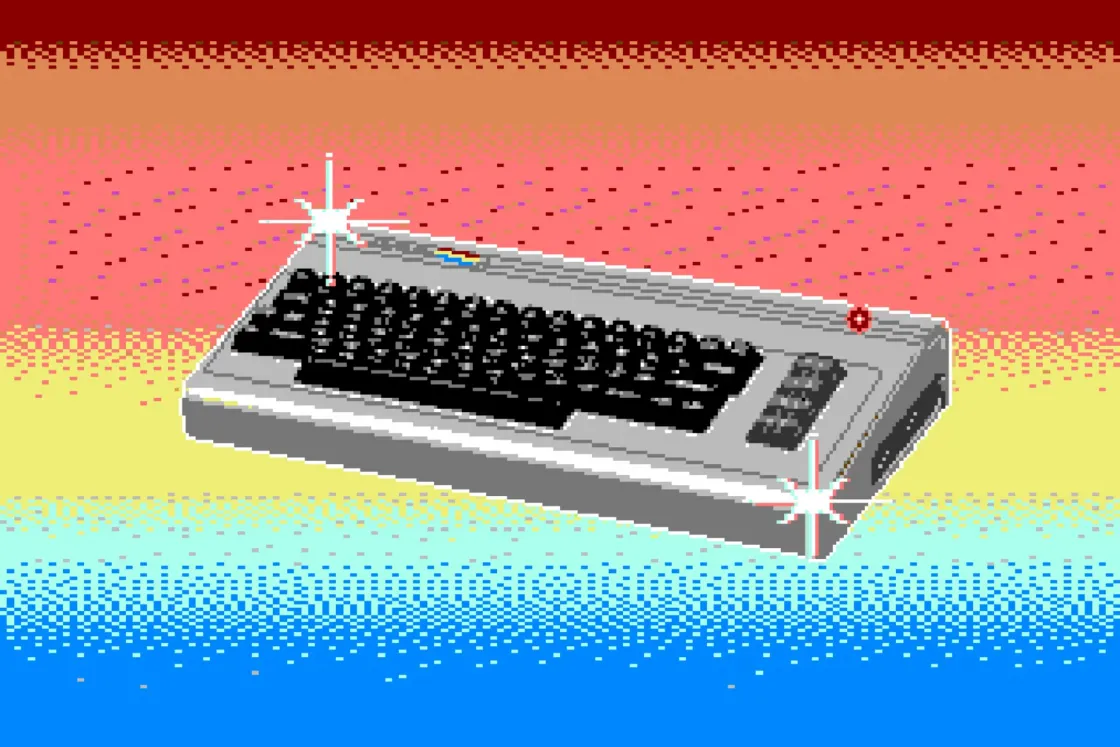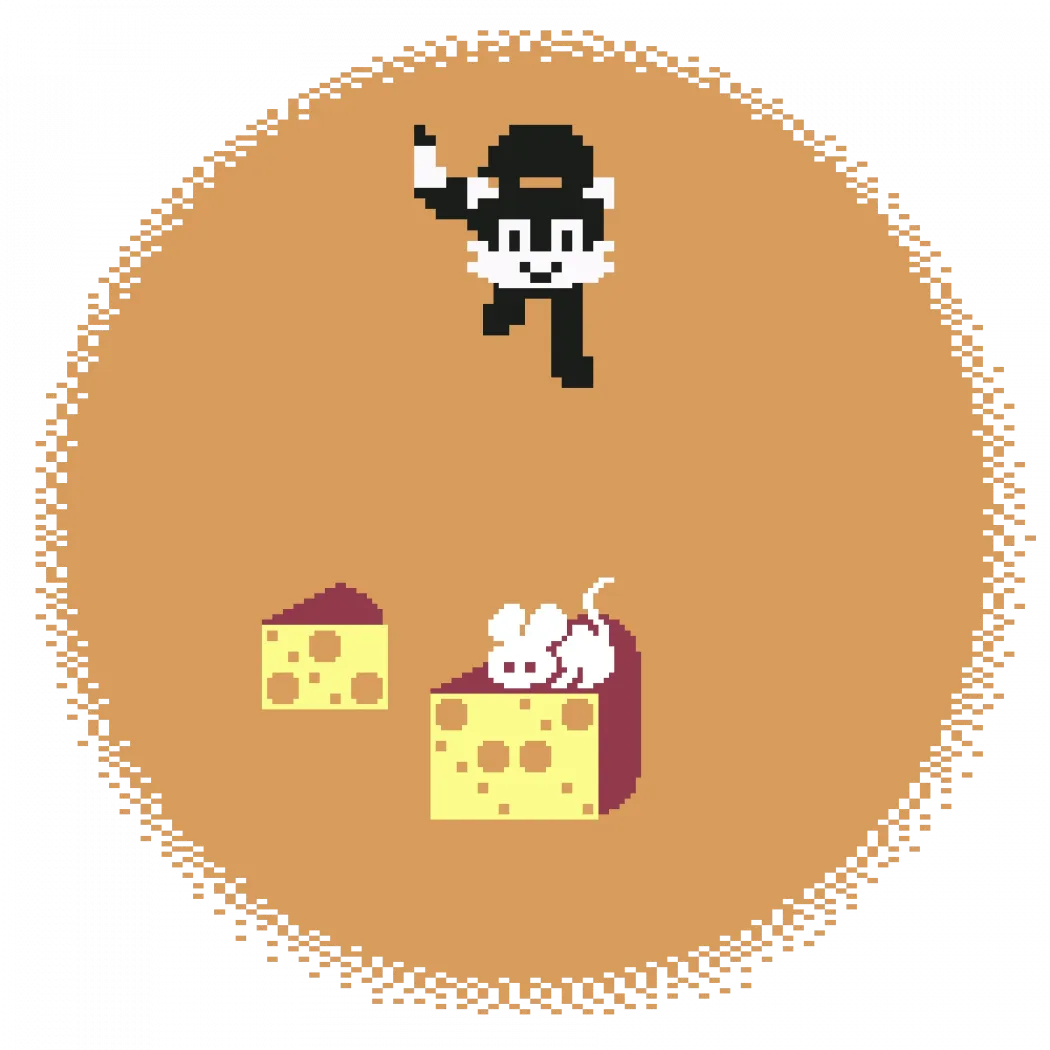
Forty years ago, one of the most successful computers ever made, the Commodore 64 was released.The C64 was loved by a whole generation in the eighties and nineties, its effect on pop-culture is felt to this day. The computer had a particularly big impact in Hungary, as it helped create the conditions needed to make high-quality video games within the socialist state and had western companies vying for Hungarian programmers. The platform is still alive today thanks to an active community, so much so that even in 2022, newly packaged C64 video games are being released.
Sometime in the second half of the 1980’s on a seemingly average day, Tamás Révbíró’s phone rang. In those days, Révbíró was the creative director of the video game-development department of Novotrade Inc. On the other side of the line was Gábor Rényi, who told him to bring his software bag and two boxes of empty disks, because they are going to Aliga. That is, to Balatonaliga, to the communist party’s holiday resort, where important MSZMP (Hungarian Socialist Workers’ Party) members were relaxing, including the then foreign secretary Gyula Horn. The holiday retreat was, at that time, receiving the illustrious Yegor Ligachyov, who was essentially the second-highest ranking man in the Soviet Union, despite firmly standing by communism and turning against the reformist Gorbachev.
Révbíró and Rényi were going to Aliga because of Ligachyov, or more accurately, Ligachyov’s grandson Andryusha, who accompanied his grandfather. The teenager had a Commodore 64 back in Moscow, but at home, Commodores were few and far between, meaning he had nobody with whom he could share and exchange programs, which was the main way of getting new software. But Hungary was a C64-superpower.
Novotrade created many games for the western markets, so Ligachyov requested someone who could copy a few new games for the kid. This someone was Tamás Révbíró, who burned two boxes of disks full of games and software while chatting with Andryusha, whose English was excellent. Meanwhile, Gábor Rényi was talking with Ligachyov and a debate broke out: he tried to convince the hard-line communist about how amazing market economies are. This, as it turns out, did not work, and only served to anger one of the most powerful potentates of the Soviet Union.
There are loads of anecdotes like this that surrounded the Commodore 64 since it was first released in 1982: by 1983, the European market was beginning to be flooded with them, and by November 1983, the Hungarian Chamber of Commerce used it to showcase some products at the London Expo. The exhibition was a success, with the first Hungarian-made games generating interest, among these Ceasar the Cat and Dancing Monster (which was featured on the cover of Popular Computing Weekly). On the fortieth anniversary of the announcement of the Commodore 64, we are looking back at why it was so important, how it became the legend it was in Hungary, why the Commodore 64 was so successful worldwide, and what tangible impact it left on our culture.

Commodore and the birth of the C64
There is no talk of the Commodore 64 without mentioning the founder of Commodore International, Jack Tramiel. The businessman was born into a Jewish family in Poland in 1928 and given the name Idek Trzmiel, surviving the hell that was Auschwitz in his teenage years. After the second world war ended, he emigrated to America, where he joined the army and learnt to fix office appliances, mostly working on typewriters. When he left the service, he worked as a taxi driver for a short time, then, using the money he had saved, he opened a typewriter repair shop. In 1955 he moved to Canada, where he founded Commodore.
Commodore first revolved around making and repairing typewriters, but within a few years they were manufacturing their very own electromechanical calculators. Tramiel stopped the production of them after recognizing that the future was in digital calculators, and entered into partnership with Casio. By the end of the sixties, Commodore had its own factory making calculators. It became apparent that in the next decade, Commodore would move towards designing computers. To make this tenable, Tramiel bought MOS Technologies, a chip manufacturer, for 800 thousand dollars, which ended up paying for itself many times over.
The next few years can be considered the golden age of Commodore, and it is from this time that most of Tramiel’s quotes are taken: that the computer must be built “for the masses, not the classes”.
The C64 became one of the company’s greatest hits.
In 1982, it ignited everyone’s fantasy at the CES expo in Las Vegas where professionals had the first chance to see it.
The Commodore 64 became dizzyingly successful. In January of 1983 they started to produce 25 thousand computers a month, a number which quickly proved to be too modest: over its life cycle, around 12.5 million of them were sold.

The C64 was on the market for a whole decade, the price of the later models going as low as 50 dollars thanks to the improvement of the technologies used. But by 1985 it seemed that the platform was on its last legs, as the demand for it in the US plummeted following the release of the NES which stole kids away from their home computers. They had just stopped the manufacture of the C64 when they realized it was just beginning to become popular in Europe.
The critical mass of people hungry for the Commodore 64 materialized later on the old continent, as in its early years the British ZX Spectrum offered a better value proposition, but also because western computers only started popping up in large numbers behind the Iron Curtain after 1985. The second half of the eighties saw a revival of the platform, only now it was flourishing in Europe.
And while in America it was used as more of a gaming-machine, it found its place as a fully-fledged computer in Europe. A whole generation of programmers were nurtured on the C64, learning the ins-and-outs of the profession. Over the continent, small semi-professional groups appeared, making games or business-centered software. One hit could make you stand out among the crowd on an ever-expanding market.
Meanwhile, Hungary was testing new ground: the predecessor of Antenna Hungária, the postal department frequently broadcasted software on channel two and Bartók radio. Anyone could record these broadcasts onto cassette and then run them on their computer as software. For years, the air was filled with ZX Spectrum and C64 programs.

The Hungarian story
Hungarians also contributed much to the triumph of the C64. The success of the games at the London expo of 1983, mentioned earlier in the article, excited the European market. Many praised the fact that, as opposed to the trend of basic shooter games, the Hungarian games were milder and more original. In those days there were not many games where one played as a mammoth who had to save castaways clinging to ice (Arctic Shipwreck), or as a Chinese plate-juggler (Chinese Juggler), or where one had to shepherd buffalo (Buffalo Roundup). Novotrade Inc., whose history intertwines with the beginning of Hungarian game development, was at the inception of these games.
That a joint stock company could exist in 1983 under socialist rule is an anomaly in itself. But that is not only what makes Novotrade a special company. In the final years of the planned economy, the company established by four banks and ninety-three companies was ordered to only concentrate on new ideas (thus the name novo trade). The company could now fit anything into its profile, whether it was publishing books or making innovations in agricultural technology, but computer hardware and software enjoyed special status and even cabinet approval.
The director of the company, Gábor Rényi, also headed the innovation department at Skála Coop not long before, and paved the way for the logic game Bábel Tornya (Tower of Babel). After this, many came to him with ideas for games, for example in 1982, László Mérő, Gábor Dávid, and Ferenc Szatmári, who had a prototype for an electronic game. This was XL25, which ended up being produced in Hong Kong and sold on the American market with the help of Rényi’s friend, Róbert Stein, who lived in London as a 1956 emigré. The stage was set for Novotrade when Stein realized that Hungarian brains could not only be used for physical games, but for video games as well.
Stein knew the marketing director of Commodore, and in 1982 they both went to Hungary. The magic happened in a restaurant named Kiskakukk: Stein took a Commodore 64 out of his bag and showed Rényi how to make games for it. The serial number was 0002, that is, the second ever C64 to be made (at first they used four digit serial numbers, which the platform soon outgrew). Jack Tramiel kept the first C64, but 0002 stayed in Hungary, and Rényi announced a competition in the January 1983 edition of the TV program: Felkínálom – népgazdasági hasznosításra (My offer for improving the national economy).
The show was based on making socialist startups by connecting the state’s resources with peoples’ ideas at a time when socialist economic policy was becoming more lenient, and one could establish business partnerships or small worker cooperatives. The competition was about submitting the best videogame ideas, with short descriptions and perhaps a bit of concept. Over a thousand people applied, and Rényi and his team spent a month going through them. They narrowed it down to twenty potential candidates of which five were selected by the director of development at Commodore, Gale Wellington.
These were pretty much the games that were then created by the end of the year and showcased at the London expo. After the positive experience, Commodore sent thirty computers to Hungary (which was an unthinkable treasure by those in the Soviet bloc), and large-scale development could begin. In the next two years, Rényi hired talented managers and directors like Donát Kiss, who hosted the TV show called Mi és a számítógép (The computer and us), and Tamás Révbíró. The programmers and graphics designers were not employees, but mainly contractors who were given an opportunity to develop a game. Recalling this time Rényi later said:
“From the nineteen-year-old students to leading researchers at KFKI [Central Physics Research Institute], all sorts of people turned up. It was an exciting time; never have I met so many talents as I did back then.”
Many wanted to see the C64 (or the ZX Spectrum, which was also new in Hungary) in person, and after experiencing the strict and secretive world of computer rooms, a new world was opened to the electrical engineers, university students and others who worked at Novotrade. And since information did not flow that well through the Iron Curtain, the Hungarians had to come up with almost everything on their own. By the end of 1983, they knew every nook and cranny of the MOS 6502 chip. They even hacked the development kit of the NES, and shocked Japanese negotiators with NES games made through unofficial means.
Success abroad and at home
It was not long before the first international hits came in: such was Eureka!, made with the king of choose your own adventure games, Ian Livingstone, or Traffic, which was popular on the Japanese market, or the revolutionary Scarabæus, one of the first to have 3D graphics ever. The news spread that Hungarian developers were not only good, but were cheap compared to western game developers, and Hungary quickly became a videogame-superpower. The sequel to Impossible Mission was made at Novotrade, for example, and the groundwork for one of the most recognizable games on the Commodore 64, The Last Ninja, was also laid by a Hungarian team (but the British System 3, who finished it did not mention them in the credits of the game). The fame of the Hungarians also traveled east, as the case of Ligachyov’s grandson shows.
This triumph started way before the dissolution of the COCOM-list thanks to the privileged position Novotrade was in. Working through the socialist bureaucracy was not simple however, as there was always a bit of anxiety when a new computer had to pass through customs. But the business was booming, and Novotrade was expanding, buying basement after basement in Újlipótváros, the 13th district of Budapest. The developers, too, realized that they were in an exceptional position: next to their fixed salary they got royalties of whatever they helped develop, and if it was a hit, they could make a small fortune. Royalties were paid in foreign currency, which could be spent in one of the country's few “dollar shops” on things that could not be found in Hungarian shops at the time.
This became less important by the end of the decade, as citizens could travel abroad more easily and “Gorenje tourism” (Hungarians traveling for the day to then-Yugoslavia to purchase western products freely available there – including household appliances made by the Slovenian company “Gorenje”) took off which also meant that there was a spike in Hungarian C64 owners, as a good number of Commodore computers found their way into the boots of Trabants and Ladas on Mariahilferstasse, Vienna’s shopping street.
As a result, the community of C64 owners also expanded. Clubs were started around the country, where people mostly exchanged and copied software (most notably at the Budapest Csokonai Community Centre, known as “Csoki”), and huge “copy parties” were held in the Petőfi Hall until the 1994 appearance of the BSA in Hungary when a police raid stopped the fun.
Novotrade stopped making games in the nineties. By the end of the eighties Novotrade opened an American division, this later turned into Novotrade International, which took over development from 1993. Later, in 1996, Sega ended up buying the company and renamed it Appaloosa Interactive, making its name with Ecco the Dolphin, and the two Contra games, the creation of which were headed by László Szenttornyai. Appaloosa had a Budapest office until 2006, when it closed after a string of unsuccessful projects.
The legend lives on
The cultic status of the Commodore 64 survives to this day in Hungary. Every edition of the Commodore World (Commodore Világ) and many Novotrade books can be found online, but we could also mention the Hungarian Commodore 64 HQ as well, one of the most expansive C64 game collections on the internet. Many Hungarian games continued to be released years after the discontinuation of the C64, such as the great Newcomer from 2001 but one of the more recent oddities, Farming Simulator 64 also deserves to be mentioned.
Yes, this is the C64 version of the incredibly popular PC game, and yes, it is an official version that Hungarians made, which is being sold by the publisher for 5 euros on its website.
Every year one can find Hungarian names in the credits of new C64 demos, and the community is brought together by such events as the annual Árok Party, which has been a tradition since the end of the nineties. It seems that even after forty years, the Commodore 64 still manages to excite. It is hard to let go, both in Hungary and elsewhere.
Translation by Allen Benjámin Zoltán.
If you enjoyed this story, and want to make sure you don't miss similar ones about Hungary in the future, subscribe to the Telex English newsletter!